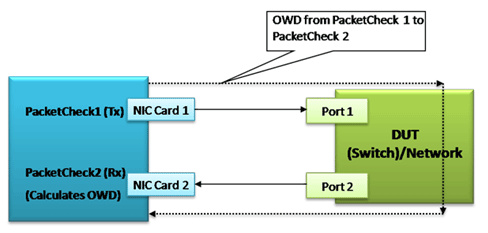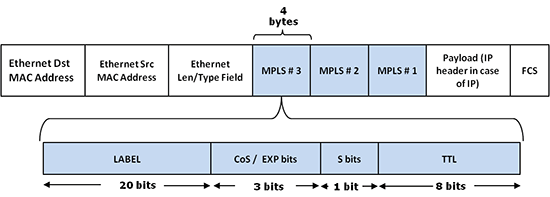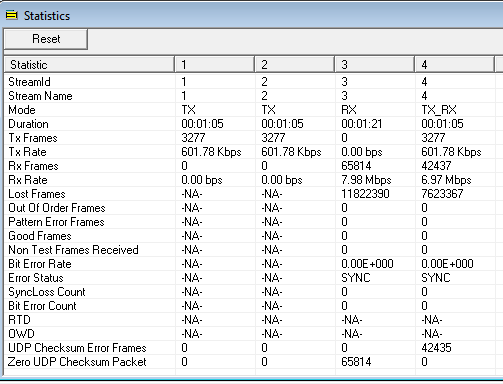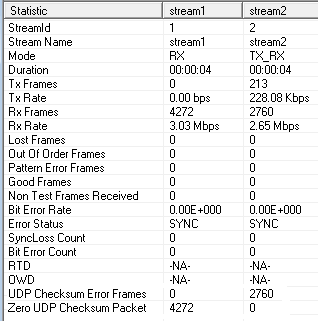GL Enhances PC based Ethernet/IP Test Tool
Welcome to another July 2015 issue of GL Communications' newsletter providing information and insight into our enhanced PC Based Ethernet Tester referred to as PacketCheck™. Now, it is enhanced to support GTP Traffic Simulation. GTP, or GPRS Tunnelling Protocol are the methods for sending IP traffic in Wireless Networks such as GSM, UMTS, and LTE.

Overview
GL's PacketCheck™ is a complete PC based Ethernet / IP test tool with BERT, Throughput, Delay, and Impairment testing functions. It is very easy to use as a general-purpose network performance test/analysis tool for 10Mbps, 100Mbps and 1Gbps LANs and WANs. Throughput up to 800 Mbps can be easily tested.
PacketCheck™ truly takes confusion out of Ethernet testing at all protocol layers - from raw Ethernet frames to IP, UDP, VLAN, and MPLS packets. It makes use of PC's network interface card (NIC) to transmit and receive Ethernet or IP packets over the network. It can generate multi-stream Ethernet, IP, or UDP traffic with on-demand bandwidth (up to 800 Mbps).
PacketCheck™ also measures end-to-end performance such as Bit Error Rate, Total Packets, Packet Loss, Out of Sequence Packets, and Error Packets. Other important features include transmission of pre-recorded file traffic, GTP traffic simulation, Bursty and Fixed IFG (Inter Frame Gap) traffic generation modes, Delay measurements including One Way Delay - [within the same PC] and Round Trip Delay, Impairment Generation, and BER Testing capability with provision to generate PRBS patterns or user-defined test patterns.
PacketCheck™ supports features like transmission of pre-recorded file traffic, which can duplicate packet traffic as it occurred at a particular Ethernet interface. It also includes a Command Line Interface (CLI) to support all the GUI functionalities of PacketCheck™ through simple commands, allowing easy scripting and automation of testing. Also included is a powerful Report Generation feature to view report in XML and PDF formats.
PacketCheck™ can operate on any of the layers - Layer 1 (Physical), Layer 2 (Data Link), Stacked VLAN (Q-in-Q), Layer 2.5 (Stacked MPLS), Layer 3 (Network), and Layer 4 (Transport - IP/UDP) of the OSI reference model.
Important Enhancement
GTP Traffic Simulation
Using the File Playback feature within PacketCheck™, the packet data can be carried as pre-recorded traffic files (GL's proprietary Ethernet traffic capture format *.HDL files) to destination points and the same can be verified at the receiving end, which can also be a PacketCheck™. This feature can be used with GL’s Mobile IP Core traffic module (requires Additional Licenses) to simulate GTP traffic over UMTS or LTE network.
Generally, in an Evolved Packet Core (EPC) network, the two types of data pipes can be found - Default Bearer (with non-guaranteed QOS) and Dedicated Bearer (with assured guaranteed QOS). To verify such bearer allocation bandwidth at the end points, the PacketCheck™ can be used with GL’s MAPS™ UMTS / LTE Simulators which allows to encapsulate the generated packet data within GTP headers and transmit through the gateway points such as SGSN & GGSN, or SGW & PGW. The packet data traffic generated at one end is received at the other end can be verified with various statistics such as packet loss, lost frames, bit error count, Tx Rx frames count and other traffic parameters.
Other Important Features
One Way Delay - [within the same PC]
One-Way Delay - [within the same PC] is defined as the time a packet takes to travel from source to destination. PacketCheck™ determines One-way Delay - [within the same PC] measurements between two NIC cards on a single PC with 2 instances of PacketCheck™ running, one on each NIC card in microsecond accuracy.

Round-trip Delay (RTD) - [between two end points]
RTD is defined as the time a packet takes to travel from source to destination and come back to same source. PacketCheck™ measures the average Round Trip Delay [RTD] by sending out special RTD packets and noting down the Sent Timestamp. It waits for the RTD packet to be looped back from the remote end, and then notes down the received timestamp. The difference is measured as the RTD value of each packet in µ sec.

Stacked VLAN
VLAN allows different hosts to be a part of the same virtual LAN irrespective of their physical location. A group of hosts connected to the same switch can be partitioned into several VLANs, or a group of hosts connected to different switches can be combined into a single VLAN. VLAN technology is used in Carrier Ethernet networks, where a common transport network carries traffic of different customer VLANs by utilizing the concept of stacked VLANs. PacketCheck™ supports customizable VLAN stacks up to 3 levels with user configurable VLAN Type, ID, and Priority.
- VLAN ID: a 12-bit field specifying the VLAN to which the frame belongs
- VLAN Priority: a 3-bit field indicating the frame priority level from 0 (lowest) to 7 (highest), which is used to prioritize different classes of traffic (voice, video, data, etc)
- VLAN Type Field: a 16-bit field indicating a newly inserted VLAN header's EtherType. The usual and widely recognized value for this is 0x8100. User can select from 5 different values - 0x8100, 0x88A8, 0x9100, 0x9200, 0x9300.

PacketCheck™ supports stacked MPLS layers up to 3 levels, customizable with headers like Label, CoS, TTL.
- A 20-bit LABEL value
- A 3-bit Traffic Class field for priority (CoS bits, also known as the EXP or experimental bits)
- A 1-bit bottom of stack flag. If this is set, it signifies that the current label is the last in the stack.
- An 8-bit TTL (time to live) field

Bit Error Rate Testing (BERT)
True BERT on layer 1, layer 2, layer 2.5, layer 3, and layer 4 with various measurements - Bit Error Rate, Sync Loss Count, Bit Error Count, and more have been introduced. PacketCheck™ calculates Bit Error Rate for the PRBS pattern being received.
ARP Packets
Capability to generate/respond to ARP requests making it easy to work with Routers. ARP packets are sent to determine the MAC address of the destination.
Common Statistics
The application supports Common Statistics and these are stream independent at the NIC card level. These statistics are gathered before stream level statistics processing and these statistics helps user to check if the NIC card is receiving any traffic, and if receiving, if it is non-test traffic i.e. traffic not belonging to any of the configured streams.
Report Generation
Report generation supports both XML and PDF formats. Reports include information such as the Statistics, Configuration Information, NIC card details, Stream Statistics, Common Statistics, VLAN, MPLS, etc with customizable headers and footers. Users can include their comments and logo in the report. Users can also generate a periodic report for the selected stream while the test is running (in XML format). Users can specify the periodicity of the report per stream.
Stream Specific and Common Statistics
This feature provide per stream measurement of throughput, round trip delay (RTD), one way delay (OWD)- [within the same PC], total packets, packet loss, out of sequence frames, error frames, correct pattern frames, pattern sync status, bit error rate, sync loss count, error count etc.

Common statistics allow monitoring receiving traffic on the NIC by aggregating the measurements on all streams on the NIC. This is mainly helps user to know if any extra traffic is being received on the NIC.


 Back to Newsletter Index Page
Back to Newsletter Index Page